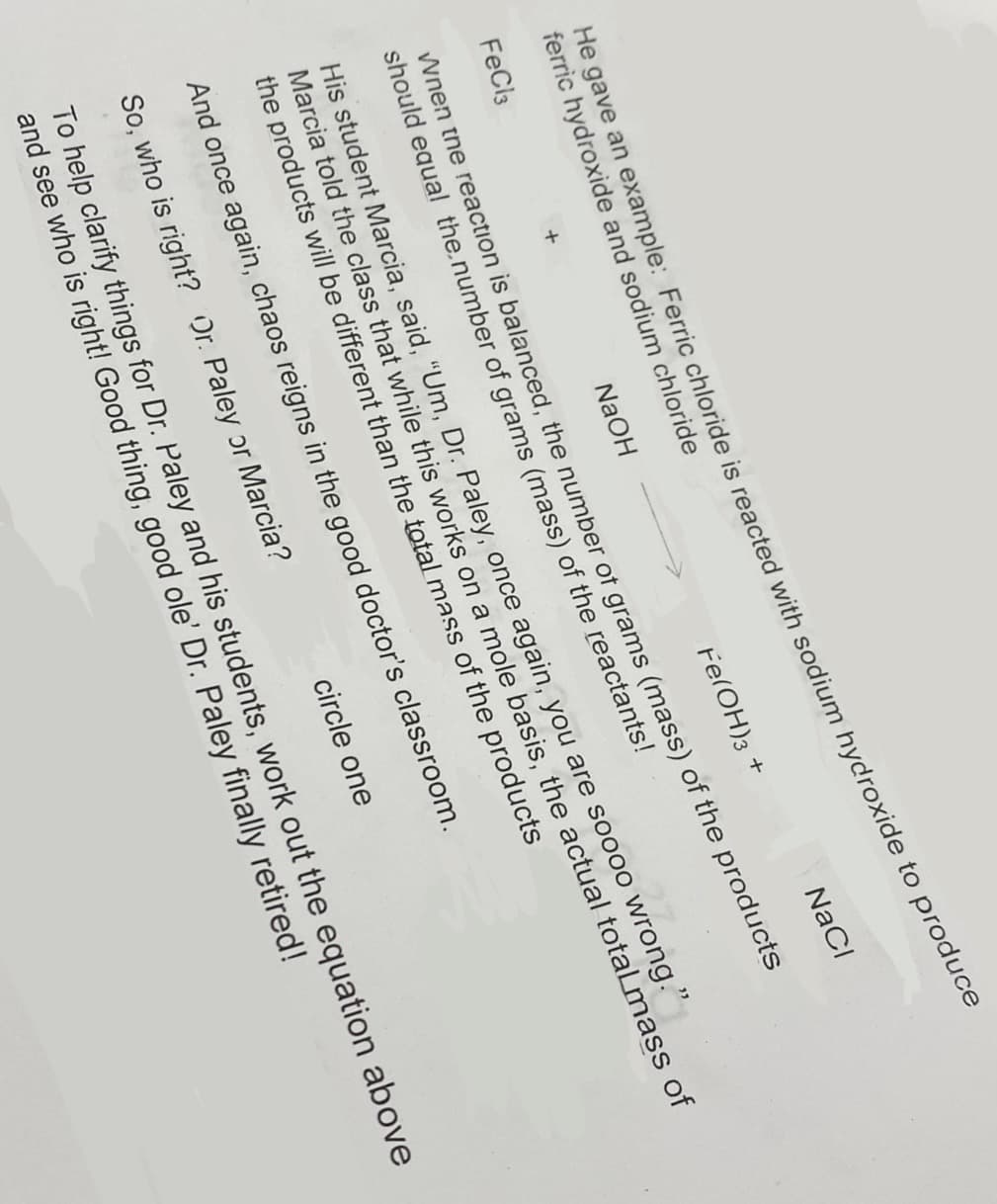NaCl He gave an example: Ferric chloride is reacted with sodium hydroxide to produce ferric hydroxide and sodium chloride FeCl3 NaOH Fe(OH)3 + When the reaction is balanced, the number of grams (mass) of the products should equal the number of grams (mass) of the reactants! His student Marcia, said, "Um, Dr. Paley, once again, you are soooo wrong." Marcia told the class that while this works on a mole basis, the actual total mass of the products will be different than the total mass of the products And once again, chaos reigns in the good doctor's classroom. So, who is right? Or. Paley or Marcia? circle one To help clarify things for Dr. Paley and his students, work out the equation above and see who is right! Good thing, good ole' Dr. Paley finally retired!
NaCl He gave an example: Ferric chloride is reacted with sodium hydroxide to produce ferric hydroxide and sodium chloride FeCl3 NaOH Fe(OH)3 + When the reaction is balanced, the number of grams (mass) of the products should equal the number of grams (mass) of the reactants! His student Marcia, said, "Um, Dr. Paley, once again, you are soooo wrong." Marcia told the class that while this works on a mole basis, the actual total mass of the products will be different than the total mass of the products And once again, chaos reigns in the good doctor's classroom. So, who is right? Or. Paley or Marcia? circle one To help clarify things for Dr. Paley and his students, work out the equation above and see who is right! Good thing, good ole' Dr. Paley finally retired!
Chemistry: The Molecular Science
5th Edition
ISBN:9781285199047
Author:John W. Moore, Conrad L. Stanitski
Publisher:John W. Moore, Conrad L. Stanitski
Chapter3: Chemical Reactions
Section: Chapter Questions
Problem 139QRT
Related questions
Question
Hello! I really need help understanding how to exactly show the number of total mass of each side of the chemical equation to make it equal and how to balence it in the first place.

Transcribed Image Text:NaCl
He gave an example: Ferric chloride is reacted with sodium hydroxide to produce
ferric hydroxide and sodium chloride
FeCl3
NaOH
Fe(OH)3 +
When the reaction is balanced, the number of grams (mass) of the products
should equal the number of grams (mass) of the reactants!
His student Marcia, said, "Um, Dr. Paley, once again, you are soooo wrong."
Marcia told the class that while this works on a mole basis, the actual totaLmass of
the products will be different than the total mass of the products
And once again, chaos reigns in the good doctor's classroom.
So, who is right? Or. Paley or Marcia?
circle one
To help clarify things for Dr. Paley and his students, work out the equation above
and see who is right! Good thing, good ole' Dr. Paley finally retired!
Expert Solution
This question has been solved!
Explore an expertly crafted, step-by-step solution for a thorough understanding of key concepts.
Step by step
Solved in 4 steps

Knowledge Booster
Learn more about
Need a deep-dive on the concept behind this application? Look no further. Learn more about this topic, chemistry and related others by exploring similar questions and additional content below.Recommended textbooks for you

Chemistry: The Molecular Science
Chemistry
ISBN:
9781285199047
Author:
John W. Moore, Conrad L. Stanitski
Publisher:
Cengage Learning

Chemistry & Chemical Reactivity
Chemistry
ISBN:
9781133949640
Author:
John C. Kotz, Paul M. Treichel, John Townsend, David Treichel
Publisher:
Cengage Learning

Chemistry & Chemical Reactivity
Chemistry
ISBN:
9781337399074
Author:
John C. Kotz, Paul M. Treichel, John Townsend, David Treichel
Publisher:
Cengage Learning

Chemistry: The Molecular Science
Chemistry
ISBN:
9781285199047
Author:
John W. Moore, Conrad L. Stanitski
Publisher:
Cengage Learning

Chemistry & Chemical Reactivity
Chemistry
ISBN:
9781133949640
Author:
John C. Kotz, Paul M. Treichel, John Townsend, David Treichel
Publisher:
Cengage Learning

Chemistry & Chemical Reactivity
Chemistry
ISBN:
9781337399074
Author:
John C. Kotz, Paul M. Treichel, John Townsend, David Treichel
Publisher:
Cengage Learning

Chemistry for Engineering Students
Chemistry
ISBN:
9781337398909
Author:
Lawrence S. Brown, Tom Holme
Publisher:
Cengage Learning

Chemistry for Engineering Students
Chemistry
ISBN:
9781285199023
Author:
Lawrence S. Brown, Tom Holme
Publisher:
Cengage Learning

Chemistry: An Atoms First Approach
Chemistry
ISBN:
9781305079243
Author:
Steven S. Zumdahl, Susan A. Zumdahl
Publisher:
Cengage Learning